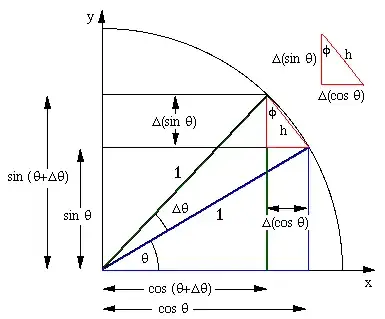It comes down to how you choose to define sine and cosine. There are multiple possible definitions, which are not obviously equivalent, but all give rise to the same functions and therefore can all be used to intuit $\frac{d}{dx} \sin(x) = \cos(x)$ and $\frac{d}{dx} \cos(x) = -\sin(x)$. I'll go through the three most common definitions:
Geometric definition:
If you're working with the geometric definitions for sine and cosine, then the geometric proof for their derivatives is clearly the most intuitive. Whether or not it is intuitive to you is a function of your intuition for geometry and calculus, not the sine and cosine functions specifically.
Differential equations:
As I mentioned in the comments, you can define sine and cosine as solutions to the differential equation $$
f(x) + f''(x) = 0
$$
with the initial value conditions $\sin(0) = 0$, $\sin'(0) = 1$ and $\cos(0) = 1$, $\cos'(0) =0$. If you've got a good intuition for differential equations, it ought to click that this uniquely defines $\sin(x)$ and $\cos(x)$. It might not be clear it's equivalent to the geometric definition. But it's trivially in this case that $\sin'(x) = \cos(x)$ and $\cos'(x) = -\sin(x)$. We observe $\sin'(x)$ solves the same differential equation, because we can differentiate both sides of $\sin(x) + \sin''(x) = 0$ and see that $$
\sin'(x) + \sin'''(x) = 0
$$
and then we also observe that $\sin'(x)$ has the initial values $\sin'(0) = 1$ and $\sin''(0) = -\sin(0) = 0$, so $\sin'(x)$ satisfies the same initial value problem as $\cos(x)$ and hence they are equal. Similarly, you can convince yourself $\cos'(x) = -\sin(x)$.
Complex analysis:
I doubt there are many people for whom this is more intuitive than the other two definitions, but I'll include it for the sake of completeness. For real $x$, we can define sine and cosine to be the real-analytic functions such that Euler's identity $e^{i x} = \cos x + i\sin x$ is true, i.e.:$$
\sin(x) = \Im (e^{i x})\\
\cos(x) = \Re (e^{i x})
$$
Then \begin{eqnarray}
\frac{d}{dx} e^{i x} &=& \frac{d}{dx}\left(\cos(x) + i\sin(x)\right)\\
i e^{i x} &=& \cos'(x) + i\sin'(x)\\
i(\cos(x) + i \sin(x)) &=& \cos'(x) + i\sin'(x)\\
-\sin(x) +i\cos(x) &=& \cos'(x) + i \sin'(x)
\end{eqnarray}
Equating real and imaginary parts yields the desired identity.
